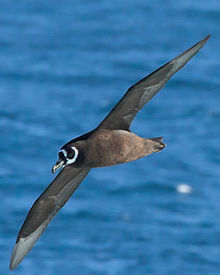Spectacled petrel
| Spectacled petrel | |
|---|---|

| |
| Scientific classification | |
| Domain: | Eukaryota |
| Kingdom: | Animalia |
| Phylum: | Chordata |
| Class: | Aves |
| Order: | Procellariiformes |
| Family: | Procellariidae |
| Genus: | Procellaria |
| Species: | P. conspicillata
|
| Binomial name | |
| Procellaria conspicillata Gould, 1844
| |

| |
| Synonyms | |
|
Procellaria aequinoctialis conspicillata | |
The spectacled petrel (Procellaria conspicillata) is a rare seabird that nests only on the high western plateau of Inaccessible Island in the South Atlantic Tristan da Cunha group. It is one of the largest petrels that nests in burrows. This species was formerly considered to be a subspecies of the white-chinned petrel (Procellaria aequinoctialis).
Taxonomy
The spectacled petrel was
The
The spectacled petrel was formerly often considered as a subspecies of the
Description
The spectacled petrel is a large, approximately 55 cm (22 in) in length, predominately black petrel. It does have white bands around its eyes, and its bill is yellow. Their lifespan averages 26.4 years.[13]
Distribution and habitat
The spectacled petrel is
Behavior
Feeding
The spectacled petrel eats
Breeding
Spectacled petrels breed in burrows on the western plateau of Inaccessible Island. The birds dig the burrows in the banks of streams and in boggy areas. The clutch is a single white egg with an average size of 81 mm × 55 mm (3.2 in × 2.2 in) and a weight of 130 g (4.6 oz).[10]
Conservation
The species was classified as
The spectacled petrel is threatened by interactions with longline fisheries which kills hundreds of birds every year as they become entangled in the fishing lines and drown.[13]
The spectacled petrel is listed on CMS Appendix II and ACAP Annex 1. A census was conducted in 2004, and Inaccessible Island is a World Heritage Site, with restricted access. To help the species, other conservation measures have been proposed. Conducting surveys of the breeding population as an ongoing process. Pushing for adoption of the best-practice mitigation measures in fisheries within this bird's range, utilizing organizations such as the Food and Agriculture Organization, Agreement on the Conservation of Albatrosses and Petrels, and International Commission for the Conservation of Atlantic Tunas. Restricting access to prevent colonization of introduced species. Finally, looking for other breeding locations.[13]
References
- ^ . Retrieved 11 November 2021.
- ^ Gould, John (1844). "On the family Procellaridae with descriptions of ten new species". The Annals and Magazine of Natural History. 13 (1): 360–368 [362].
- ^ Linnaeus, Carl (1758). Systema Naturae per regna tria naturae, secundum classes, ordines, genera, species, cum characteribus, differentiis, synonymis, locis (in Latin). Vol. 1 (10th ed.). Holmiae (Stockholm): Laurentii Salvii. p. 131.
- ISBN 978-1-4081-2501-4.
- ^ Gotch, A. T. (1995)
- ^ Rasmussen, Pamela, eds. (July 2021). "Petrels, albatrosses". IOC World Bird List Version 11.2. International Ornithologists' Union. Retrieved 6 January 2022.
- ^ Double, M. C. (2003)
- ^ Ehrlich, Paul R. (1988)
- ^ Mayr, Ernst; Cottrell, G. William, eds. (1979). Check-List of Birds of the World. Vol. 1 (2nd ed.). Cambridge, Massachusetts: Museum of Comparative Zoology. p. 86.
- ^ .
- ISBN 978-0-9568611-0-8.
- .
- ^ a b c d e f g BirdLife International (2009)
- ^ .
Sources
- BirdLife International. "Spectacled Petrel - BirdLife Species Factsheet". Data Zone. Retrieved 6 January 2022.
- Double, M. C. (2003). "Procellariiformes (Tubenosed Seabirds)". In Hutchins, Michael; Jackson, Jerome A.; Bock, Walter J.; Olendorf, Donna (eds.). Grzimek's Animal Life Encyclopedia. Vol. 8 Birds I Tinamous and Ratites to Hoatzins. Joseph E. Trumpey, Chief Scientific Illustrator (2nd ed.). Farmington Hills, MI: Gale Group. pp. 107–111. ISBN 0-7876-5784-0.
- Ehrlich, Paul R.; Dobkin, David, S.; Wheye, Darryl (1988). The Birders Handbook (First ed.). New York, NY: Simon & Schuster. pp. 29–31. ISBN 0-671-65989-8.)
{{cite book}}: CS1 maint: multiple names: authors list (link - Gotch, A. F. (1995) [1979]. "Albatrosses, Fulmars, Shearwaters, and Petrels". Latin Names Explained A Guide to the Scientific Classifications of Reptiles, Birds & Mammals. New York, NY: Facts on File. p. 192. ISBN 0-8160-3377-3.

